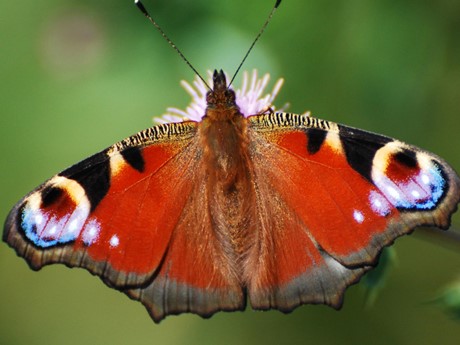Remembering important phenologist, Jean Combes
Alex Marshall, 01/07/2024
Around the world there are countless people who dedicate their lives to a cause that means so much to them, quietly making the world a better place.
One of those passionate people, and who dedicated a huge amount of her time and energy to UK environmental conservation and education, was Jean Combes OBE.

Jean Combes OBE. Credit: Gill Combes
About Jean
Last year in 2023, environmentalist and important phenologist, Jean Combes, passed away at the age of 96.
Jean was passionate about trees, plants, birds and butterflies. Every year from the age of 20, she recorded the dates when four tree species came into leaf. What started as a youthful project driven by a simple love of nature, turned out to demonstrate with text-book clarity that the long-term trend is for spring to start significantly earlier. Her 76-year dataset has been used by climate scientists in modelling and proving the effects of climate change, and earned her national recognition with the award of an OBE in 2008.

Jean Combes aged 3 in 1930, trying out binoculars on a windy beach, a taste of things to come.
After raising three daughters as a full-time mother, Jean returned to education and completed a Field Biology qualification. This was the springboard for 25 years teaching natural history adult education classes for the Workers’ Educational Association, Guildford University and the Field Studies Council. Alongside her teaching, Jean undertook survey work, including 20 years of the Common Bird Census on Ashtead common. Her survey of a proposed oil pipeline route through Surrey and Sussex successfully safeguarded the habitats of several rare plants. She was actively involved in wildlife committees including Local Agenda 21, Surrey Wildlife Trust, Mole Valley Council and the City of London committee managing Ashtead Common. Her fine pencil drawings of tree buds, catkins and leaves were exhibited annually for ten years at the Botanical Society of Britain and Ireland.
-words taken from Jean's Obituary

Jean with her three daughters on the south downs on holiday, 1965.

Pencil drawings by Jean Combes OBE.

The importance of observation
Phenology is the scientific study of seasonal changes in plants and animals from year to year, and especially their timing and relationship with weather and climate.
Jean Combes was responsible for what is believed to be the longest phenological record collected by a single person anywhere in the world. Her records form part of the Nature’s Calendar database, the UK’s only phenological database.
In 1995, Professor Tim Sparks published a paper on an analysis of the Marsham family records. This resulted in quite a lot of publicity in the national newspapers. Jean read one of those newspaper articles and got in touch with Tim Sparks regarding her records. Sparks subsequently published Jean’s data and was instrumental in setting up the UK’s only phenological database, Jean agreed to her data being added to the database, which in 2000 was named Nature's Calendar.
We would like to take a moment to acknowledge her phenomenal contribution to the science of phenology and her dedication to the natural world.
Before her death, Jean passed the phenology baton onto a friend of hers, Janice Fisher, who will continue to record budburst dates for her trees, starting with the year 2024.

Oak budburst – photo credit Kylie Knight WTML
Nature’s Calendar volunteers record the dates of certain events that happen to certain species during the changing seasons, such as the flowering of plants, emergence of insects and migration of birds. There are over 150 different species events to record.
Observing seasonal events can show how moments in an organism’s lifetime can be affected by weather and climate. This helps scientists to understand what an increase in global temperature or extreme weather conditions could mean for the survival of plants and animals, as well as the reproduction success and behavioural changes such as migration, feeding and mating behaviours. All of this is vital in understanding how best to protect species from the impacts of climate change.
The Nature’s Calendar database has been used in lots of scientific studies, as well as in national reports such as the State of UK Climate report and the seasonal Nature’s Calendar reports
Jean’s nature diaries
Jean Combes recorded a range of data since she began in 1947, including: first leafing and first flowering dates for various tree species, first bird nesting dates, bird migration dates, and the weather conditions. Take a look at some of Jean’s diary entries below.

Here is a copy of Jean’s phenology diary, dated 1947, the year she began her records. Image courtesy of Gill Combes.

Here are pages from Jean Combes’ phenology diary from the year 1955.

Here are pages from Jean Combes’ phenology diary from the year 1955.

Oak and Ash leafing dates from 1947 to 1977.

Bird migrant arrival dates from the year 1974.
Jean’s records were instrumental in showing that spring in the UK is starting earlier.
The oak budburst dates collected by Jean have become famous. They have been used by scientists, government departments and research organisations interested in the impact of a changing climate on trees and wildlife. Dates from 1950 to 2024 are shown in the graph below. Budburst dates vary hugely from year to year, but the general trend is towards budburst happening weeks earlier than it used to.

Feeling inspired?
Every single Nature’s Calendar record adds vital information to our database, whether you add one record or hundreds, whether you record one species or many. If you do not already record for Nature’s Calendar, why not give it a try? Register for an account and read our webpage for more information on how to get started.

A poem written by Jean Combes in 1965

Pencil drawings by Jean Combes OBE.

